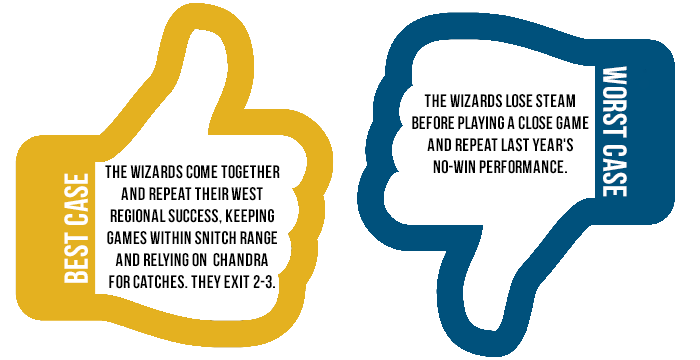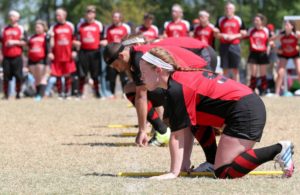- Rule, Britannia, no more?
- Unpopular Opinions: US Quadball Cup 2023
- Proven Contenders: University of Virginia
- Proven Contenders: Rutgers University
- Proven Contenders: University of Michigan
- Proven Contenders: Creighton University
- Different Perspectives: A Look Inside USA Ultimate
- Antwerp QC, Much of Belgian Core, Leaves Competitive Quidditch
Part XVII
- Updated: March 11, 2015
Rock Hill Roll Call is your in-depth guide to the 80 teams that will compete for the title of World Cup 8 Champion. We’ve reached out to writers and analysts all over the country to bring you the lineups, strategies, focal points and aspirations of each and every attending team. Whether you are looking for a leg up on the competition or just want a detailed preview of the sport’s main event, this is the place for you.

 By Sean Pagoada
By Sean Pagoada
University of South Florida runs a tight defense through some of the best beaters in the region and the shot-blocking prowess of captain and coach Baustin Archie. The team was able to complement its defense at the South Regional Championship with a hero-ball offense on the back of chaser Jody Louis. The Bulls brought their biggest squad yet, so expect an even larger roster come World Cup 8.
Despite premiering its largest roster to date, South Florida listed a mere two female players on their regional roster: chaser Teresa Parsons and beater Devin McCauley. Day one of World Cup will force teams to face a grueling five-game schedule, and if an injury is to befall one of these women, the running of the Bulls will end then and there.
Another factor South Florida must overcome is the attitudes of certain players. Beater Austin Webster received a red card in the first minute of the Bulls’ last game of day one at the South Regional for cursing at another player. A red card is bad enough, but Webster drew the penalty in a high-stakes game that would determine the first seed in the pool, potentially earning the winner a trip to World Cup. The South Florida players will need to keep their heads in the game and themselves out of the penalty box–otherwise the Bulls will not have any players left on the field.
The shining star of the South Regional was Matthew Clevenger, who has become the Swiss Army knife for the South Florida squad. Clevenger caught the snitch in one of the Bulls’ SWIM games at the tournament, played chaser every game and stepped up to a dual-male beater set with Daniel Velazquez once Webster was out of the game. If Clevenger can continue to act as a clutch player, the Bulls can hold their heads high when their games are within reach of a victory.
If the Bulls can keep attitude in check and avoid injuries, there extensive roster will prove to be their x-factor at World Cup 8.
 By Anonymous
By Anonymous
South Florida is anchored off the field by coach and captain Archie. When the team steps on the pitch, he sets the Bulls up defensively as well as gives the team alley-oops here and there. The Bulls prefer to run a standard lineup, opting for a dual-male beater set only to mirror opponents. When holding bludger control, the Bulls run a tenacious defense. The physical and aggressive point-defense of Louis combined with pin-point positioning from beater Webster and the shot-blocking power of both keepers Archie and Blain Falone make for a frustrated opposing offense.
 As a pioneer of Bull Rush (known as 1.5 outside of Florida), it comes to no one’s surprise that the Bulls use this strategy as often as possible. When combined with chaser Louis, the strategy will typically be met with a goal, the exception being when up against only the best chaser defenses. When the beaters are putting on this sort of pressure, it makes things easier for supporting players like Andres Cedeno, who will try and use his speed in open space when he is chasing or making clutch grabs at seeker.
As a pioneer of Bull Rush (known as 1.5 outside of Florida), it comes to no one’s surprise that the Bulls use this strategy as often as possible. When combined with chaser Louis, the strategy will typically be met with a goal, the exception being when up against only the best chaser defenses. When the beaters are putting on this sort of pressure, it makes things easier for supporting players like Andres Cedeno, who will try and use his speed in open space when he is chasing or making clutch grabs at seeker.
Two of the Bulls’ more unassuming players are Clevenger and Velazquez. They might not look the part, but when the game is on the line, these two will do what is necessary to finish on top. Velazquez is a four-year beater, having beat for South Florida and Florida’s Finest in the past. Clevenger has not played nearly as long as Velazquez, but he has also played for both teams. Clevenger will be utilized in just about every position for the Bulls and is their most consistent and reliable player.
 By Ryan Donahue
By Ryan Donahue
The Wizards of Westwood have never struggled to fill their beating line. They even have a tendency to recruit too many beaters to fit into a reasonable rotation. While this may be problematic for teams that desire more chasers, the Wizards have turned it into a strength.
UCLA’s B-team will show up to World Cup 8 with a roster filled with beaters who have spent the past two years building a synergy that will be their team’s best hope for success on the national level. These players are versatile in their ability to approach any strategy with ease, and the skill level is relatively even among each member of the line. These two traits make it so frequent substitutions will barely affect the Wizards’ flow of play.
 Physicality, however, could make or break the Wizards.
Physicality, however, could make or break the Wizards.
Being unaccustomed to physical play, the squad’s chasers will struggle against teams that make big hits. The Wizards’ lack of physical chasers paired with their small number of males at the position might make it hard for them to play up to their more physical opponents. That being said, while not particularly aggressive themselves, the Wizards’ beaters have shown that they can handle physicality and come out ahead.
At LA Open, the team’s first tournament this season, the Wizards were forced to reevaluate their beat-first approach to taking hits. Notably, Rachel Swanson and Nicole Finegan nonchalantly demonstrated a bludger-passing style of beating that helped them overcome the more aggressive 1.5 beater plays that they came up against. The experience, synergy and depth of the Wizards’ beaters will help their team put their best foot forward in Rock Hill.
 By Ryan Donahue
By Ryan Donahue
Having started as a hastily organized team of mostly underclassmen who wanted to compete in 2012’s Western Cup III, the Wizards have certainly come a long way.
At the 2013 West Regional Championship, the Wizards featured, once again, a roster of inexperienced players. However, the team competed for the first time on the official level and ended the tournament just short of receiving a bid for World Cup. This year’s West Regional saw the Wizards at the best they have ever been.
They were able to secure a bid because they are no longer epitomized the inexperienced team they once were. Their veteran players, notably co-captains Badal Chandra and Lauren Fitzgibbon, led the team in taking the final bid from the West this year. However, many of the fast plays and transition offenses that got the Wizards through the regional would have been hard to accomplish without chasers such as Javier Cervantes, Sean Myers and Eric Adar Carver. Even with these key players leading the charge, the Wizards’ lack of male-chaser depth means they will likely play a majority of their games with an equal gender ratio.The Swiss format of World Cup 8 should benefit this team by giving it a better chance for even matchups, but its greatest hurdle will be keeping its energy up for later wins. Relying heavily on a few chasers to actually put points on the board may wear the Wizards out before they make it to their more favorable matchups.
 By Luke Changet
By Luke Changet
This one is simple. Ball State University’s x-factor is captain and beater Andrew Derry.
Derry is filling the shoes of Trevor Campbell, who is on hiatus due to commitments outside of quidditch. In the past, when both beaters were on the team, Ball State dominated the bludger game against almost every opponent. With Campbell gone, Ball State’s beaters are left with a huge question mark.
 Derry was considered an elite beater when he played for Central Michigan University, but his name has not carried the same notoriety in his time at Ball State. This may be due, in part, to playing in Campbell’s shadow.
Derry was considered an elite beater when he played for Central Michigan University, but his name has not carried the same notoriety in his time at Ball State. This may be due, in part, to playing in Campbell’s shadow.
The new captain needs to step up more often and play a highly-aggressive defense that forces a lot of turnovers since Ball State’s strongest offense is its transition game. While little film shows it, Ball State is best when it gets opportunities to make fast breaks. Starting keeper Blake Fitzgerald and chaser Anthony Votaw both thrive on the fast break, and if Derry can force enough turnovers to get these two into open space, Ball State’s offense will score. A lot.
However, if Derry cannot play the role required of him, Ball State’s offense will grind to a halt. As quick as the team is in transition, it is just as slow in the half court. This offense relies on beaters making plays to open up lanes for the chasers. If the beaters are not playing the way they need to, this offense is stagnant and doomed to fail.
 By Luke Changet
By Luke Changet
The most notable feature of Ball State is that there’s really nothing at all noteworthy about the team.
The Cardinals’ chasers are fast and physical, but not lightning quick or big hitters. Their beaters are smart and well-utilized, but they lack cannon arms and sticky hands. Their seeker, Jason Bowling, while tall and lanky, is not super fast or strong, but somehow always seems to come away with the snitch.
Ball State is a good team. It will not shoot itself in the foot, but it will not dominate the better teams at World Cup 8. When the Cardinals face a team that dominates a game in one way or another, they may falter because they will not be strong enough to match it. But until they play that team, there’s no reason why Ball State will not secure a spot in bracket play.

Graphics and photo illustration by Amanda Dallas. Original photos by Monica Wheeler (NAU, Gambits) and Will Michels (Texas).







